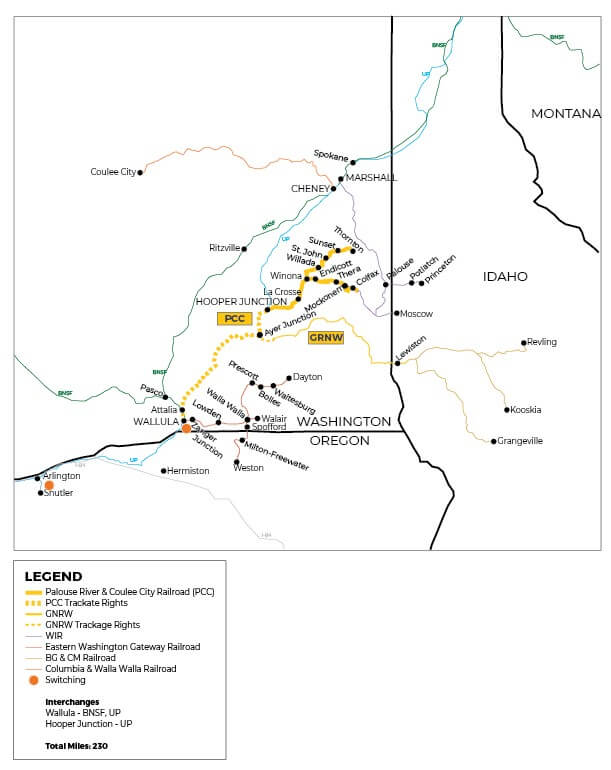forum
library
tutorial
contact

Rail Investment Powers Economic
Growth and Community Connectivity
by Bruce Agnew & Al French
The Spokesman-Review, October 3, 2023
|
the film forum library tutorial contact |

|
Rail Investment Powers Economic
by Bruce Agnew & Al French
|
To move our region's rail network forward,
we need everyone on board.
 The Greater Northwest was built around the railroads. Towns were founded more than 100 years ago along the rail network. The foundation of Spokane's rail network was established even before the town received its charter in 1881.
The Greater Northwest was built around the railroads. Towns were founded more than 100 years ago along the rail network. The foundation of Spokane's rail network was established even before the town received its charter in 1881.
The train tracks are still here and are used to this day. Rural communities across the Greater Northwest rely on the rail network to move people and goods.
On Oct. 8 and 9, the Greater Northwest Rail Summit will convene at the Spokane Public Library to explore ways to revisit the critical importance of railroads to our economy and environment.
Greatly expanded federal funding from the Infrastructure Investment and Jobs Act will be a major topic as we bring together railroads, ports, freight and passenger rail advocates, elected leaders, tribal nations and shippers to find common cause in support of railroad infrastructure.
Today, the Inland Northwest remains a vital rail hub for BNSF Railway and Union Pacific Railroad that connect the region's diverse commodities to global markets. Trains moved 50.1 million tons of freight in 2021, taking the equivalent of 4.1 million trucks off the road, according to GoRail.
Short line freight lines like the stateowned Palouse River & Coulee City Railroad are critical pieces of the local economy and recently received a $72 million federal grant to better transport wheat, lentils and barley to regional and global markets. The Washington state Legislature is also considering a short line modernization tax credit to better serve local markets.
More frequent passenger rail service may be on its way, too.
The Amtrak Empire Builder connects Spokane and Sandpoint to the Amtrak Cascades network with growing ridership from British Columbia to Oregon as well as Amtrak's growing national network.
The Federal Railroad Administration awarded the Montana-based Big Sky Passenger Rail Authority a Corridor Identification and Development designation for the Big Sky North Coast Corridor, making it the only new long-distance route in the U.S. for future development. The North Coast will complement the Empire Builder along the HiLine in northern Montana with a southern Montana route linking Sandpoint, Missoula, Helena and Billings on the way to Seattle or Chicago.
Local passenger train service could increase from one train a day east and westbound to three or four trains. In addition to expanded tourism, more frequent rail service will provide dependable access for rural areas and tribal nations to Spokane's critical medical facilities.
With unprecedented funding at the national level, now is the time to focus local attention and investment on a regional High Performance Rail network. HPR explores partnerships with railroads to identify logical places for joint investment.
Two excellent local examples are the Spokane Valley Pines Road BNSF grade separation project and the consolidated BNSF rail crossing and highway overpass at State Highway 53 at Hauser. Both projects will reduce local travel and emergency responder delays, train/vehicle accidents and noise from train whistles.
To move our region's rail network forward, we need everyone on board -- growers, shippers, small communities and advocates, railroads, tourists, state institutions and local governments, elected officials, tribal nations and the private sector. When the entire Greater Northwest comes together to prioritize rail as a cheap, clean, efficient, and safe way to move people and goods through the region, we'll be able to secure enhanced federal funding and advance High Performance Rail investments at the local level.
Come join us at the library on Oct. 8 and 9. Remote access is also available. Find more information at www.nwsummit.org.
learn more on topics covered in the film
see the video
read the script
learn the songs
discussion forum
